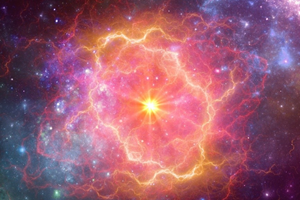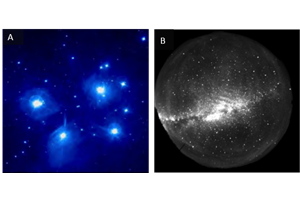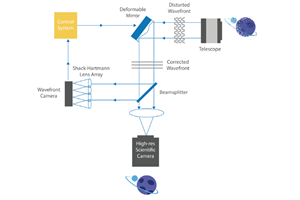Introduction
Exoplanets are planets that orbit a star other than the Sun, and their detection and characterization has been at the forefront within astronomy for multiple years. To date there has been greater than 4000 exoplanets confirmed across a range of different methods, with more than 5000 additional exoplanet candidates. Over the next decade, characterizing habitable exoplanets will be one of the key research areas within astronomy, with the goal to find Earth-like planets. Although there are multiple detection methods, transit photometry and radial velocity are the most common techniques for exoplanet detection/characterization, with each method discovering 71.3% and 22.9% of exoplanets respectively [1].
Transit Photometry
Transit photometry is an indirect method that measures the decrease in flux of a star caused by an orbiting planet passing in front of the star [2]. Measurement of the star’s flux produces a light curve, and when a planet passes in front of the star some of its light will be blocked, indicated by a slight dip in the light curve. Figure 1 shows a schematic of the transit of an exoplanet and the typical light curve produced (figure is only illustrative, and the curve is exaggerated).
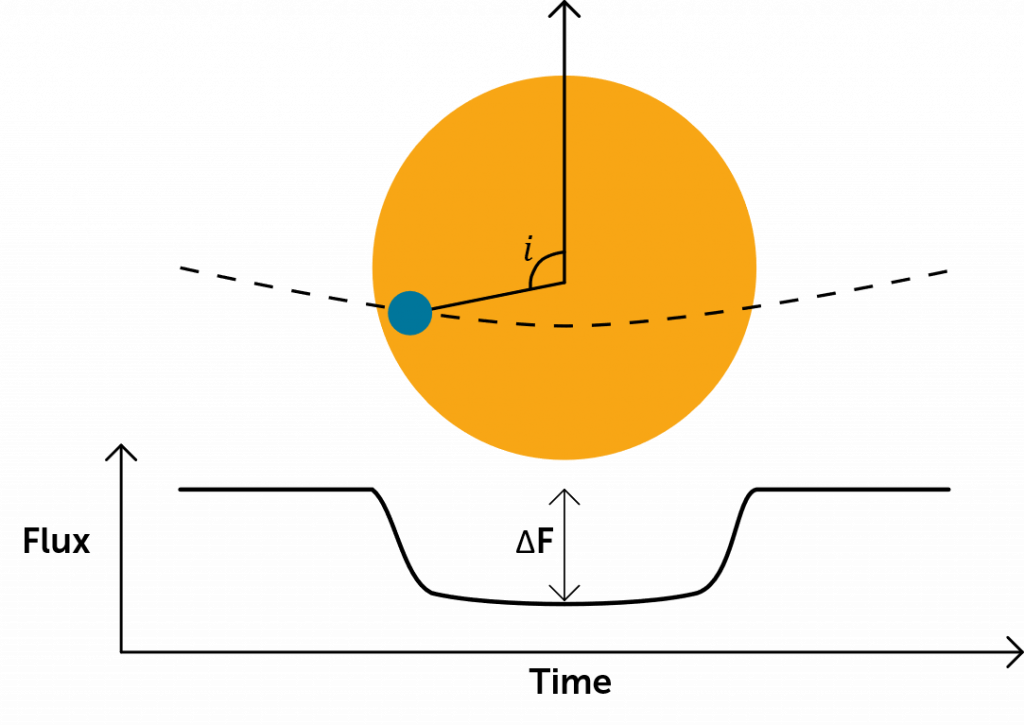
By assuming that the planet’s flux is negligible, and that the star and planet are both spherical, the light curve can be used to determine the relative size of the planet, the inclination of the orbit and the orbital period. Transit photometry can also be combined with the orbital elements whenever an orbital solution, based on radial velocity measurements is available (see below). In this case the inclination of the orbit can be used to determine the mass of the planet. Combining the mass with the planet radius we get mean density and surface gravity. These parameters represent the first step in planet characterization, helping to distinguish between gas giants, icy and rocky planets[2].
Atmospheric characterization can also be achieved via transit photometry. By measuring the transit of the planet using different filters, the variations in the light curve can indicate the presence of certain molecules. For example, water molecules absorb near-infrared light so if they are present within the atmosphere of a planet, the atmosphere will be opaque to near-infrared wavelengths. When a near-infrared filter is used, the planet will block more light overall, due to the less transparent atmosphere. This means the eclipse will start earlier and end later in comparison to optical wavelengths, producing a light curve with a deeper and wider minimum.
However, this method is limited by geometry, as only planets that pass in front of the star, relative to Earth, can be studied in this way. Transit photometry also suffers from false positives, although a light curve characteristic of a transiting planet is measured, the flux may instead come from a multiple stellar system. An example of a false positive is an eclipsing binary star that is on the same line of sight with a bright single star. The flux of the single star reduces the apparent depth of the light curve dip caused by eclipsing binary. The resulting light curve is similar in shape to a transiting planet [2]. In order to confirm that a transit planet candidate is not a false positive, radial velocity measurements of the system are required.
Radial Velocity
Radial velocity is another indirect technique that measures the spectra of a star to look for a variable Doppler shift, indicative of an orbiting planet. Star-planet interaction is governed by gravity, so as the star pulls on the planet the planet pulls on the star, resulting in the star moving in a periodic motion, often referred to as a “wobble”. By measuring the spectra of the star, any movement towards and away from Earth will be observed as blueshift or redshift of the spectrum respectively, indicative of an orbiting planet.
In this way the Doppler effect can be used to determine the planet’s orbital period, the size of the orbit and orbital velocity. The latter can provide a minimum mass of the orbiting planet. The more massive the planet, the larger the velocity amplitude. However, to determine the true mass of the planet, transit photometry is required as radial velocity by itself cannot account for the inclination of the orbit [3]. Figure 2 shows a schematic of a star-planet interaction and how this influences the spectra of the star.
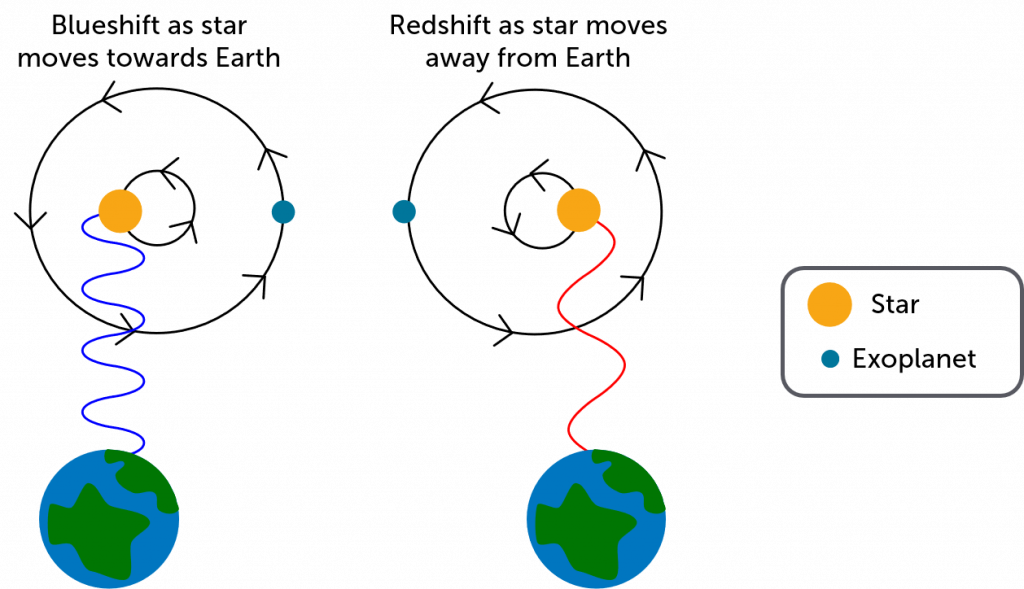
As radial velocity measures the relative masses of the orbiting bodies, it can be used to rule out any false positives from exoplanets detected via transit photometry. In case of an eclipsing binary, the expected Doppler shift amplitude is large as the objects are of comparable masses. Therefore, radial velocity variations in a ball park of a few hundred meters per second or more will robustly distinguish a binary star from a transiting planet, confirming any false positive.
Both transit photometry and radial velocity measure the slightest of variations in a star’s flux as function of time or wavelength. Therefore, these techniques rely heavily on advanced detector technology to successfully detect and characterize exoplanets.
Camera requirements
Detection and characterization of exoplanets via transit photometry relies on the detection of a small variation in the flux of a star. These variations, or dips, in flux are typically less than 1% of the true flux of the star. Therefore, a camera with high precision is essential to measure any slight decrease in flux. In addition, a camera with large dynamic range and low noise further improves the likelihood of identifying an exoplanet, as any dip, or spectral feature, can be differentiated from the noise level.
Transit photometry typically requires dense observations once the planet traverses in front of the star. These high frame rate observations are essential to capture the maximum amount of data for each transit and to counteract for the inhomogeneity of the star, in particular the edge of the star or active regions (stellar spots) that a planet may cover during its passage. It also allows for parameters such as planet size and inclination to be determined. Therefore, a camera with a high duty cycle (i.e. minimal readout with respect to exposure) is vital to allow for this high cadence imaging. The combination of high precision, low noise, large dynamic range and high duty cycle allows for dense observations while maintaining a high signal to noise ratio.
Radial velocity, although a spectroscopic technique, still requires advanced camera parameters such as those stated above. Fringing (interference of photons within the camera sensor) can be extremely problematic for radial velocity as it causes a sinusoidal modulation on the top of any measured spectrum. Radial velocity relies on the cross correlation of spectra, so any fringing artifacts will affect the accuracy of cross correlation and therefore reduce the accuracy of exoplanet characterization.
In addition, having a good charge transport efficiency on the camera sensor is important. If either some charge is left behind, or there is some correlated noise between pixels, this will influence cross correlation negatively affecting detection or characterization of exoplanets. However, this is only something that needs to be taken into consideration when using a CCD or EMCCD sensor.
COSMOS for transit detection and radial velocity measurements
COSMOS, the large format, back-illuminated, advanced CMOS camera from Teledyne Princeton Instruments, has many of the camera qualities required for transit photometry and radial velocity measurements. Due to its back-illuminated sensor, COSMOS has a >90% peak quantum efficiency in the visible range, as shown in Figure 3. Therefore, even with high cadence imaging, COSMOS will be able to convert a high percentage of photons into photoelectrons. COSMOS can also achieve down to 0.7 e- read noise, making COSMOS suitable for detecting the slightest dips in a light curve. In combination with high quantum efficiency, this low read noise provides a high signal to noise ratio for the ultimate large format CMOS sensitivity.
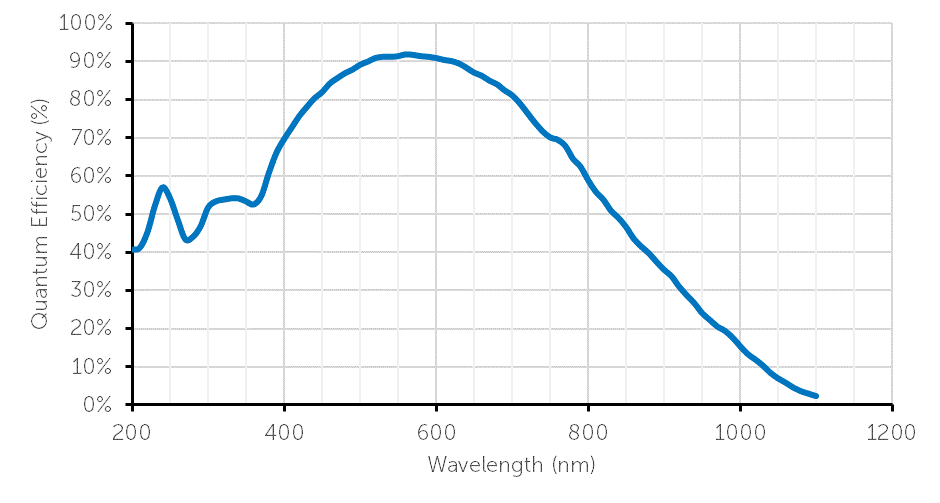
Large dynamic range is important within transit photometry and radial velocity as it allows for slight fluctuations to be determined. It also allows for the measurement of fainter signals without saturation of the detector from surrounding brighter objects. Dynamic range is a parameter that depends on camera linearity, analog-to-digital converter bit-depth, and gain. To extend dynamic range, CMOS cameras typically sample the signal multiple times at both high and low gain. However, the cross-over point between these high and low gain readouts can produce artifacts which limit measurement precision [4].
Advanced CMOS designs, such as those within COSMOS, ensure precise cross-over between both ADCs for operation with low noise and high linearity. By combining with higher bit-depth ADCs, the technology provides unsurpassed dynamic range. More details about the large dynamic range of LACera™ technology, used within COSMOS, can be found in our article New Era in High Dynamic Range CMOS.
Traditional full frame CCD sensors rely on a mechanical shutter to block any incident light during readout. Opening and closing mechanical shutters is a relatively slow process, introducing quantitative errors for high cadence imaging. Mechanical shutters also have finite lifetimes and often need to be replaced frequently when the camera is in heavy use. As COSMOS is a CMOS detector, it utilizes a fast, electronic shutter where exposure is stopped by shifting detected photoelectrons into a frame storage area before readout. Not only is an electronic shutter more precise than a mechanical shutter, but also leads to less dead time of the detector, during which the camera is not exposing to light. This means that subsequent exposures can already start as signal is readout from the storage area, providing a 100% duty cycle. This allows dense, high cadence imaging essential for measuring characteristic parameters of an exoplanet.
Conclusion
Exoplanet detection and characterization will be at the forefront of astronomy over the next decade. Transit photometry and radial velocity, two complementary techniques, have been used to discover a cumulative 94.2% of all exoplanets. Transit photometry is an indirect method that looks for a dip in a stars brightness due to a planet traversing in front of the star, whereas radial velocity looks at the Doppler shift of the star due to the gravitational pull from an orbiting planet.
Both techniques require high precision, and a camera with low noise, large dynamic range and high sensitivity. Transit photometry also requires a camera with a high duty cycle, as a dense number of frames taken at a high cadence is typically used for imaging a potential planet as it crosses the star’s surface. Radial velocity, a spectroscopic technique, can be greatly hindered by fringing, so requires a camera with as minimal fringing as possible.
COSMOS, with >90% peak quantum efficiency, low read noise of 0.7 e-, and large dynamic range meets the minimum camera requirements for both transit photometry and radial velocity. In addition, the 100% duty cycle, made possible by the CMOS sensor architecture and electronic shutter, allows for high cadence imaging typical of exoplanet detection and characterization. This makes COSMOS optimal for transit photometry and radial velocity methods.
Acknowledgements
Teledyne Princeton Instruments would like to thank Professor Nikolai Piskunov, Uppsala University, for his invaluable contributions to this application note.
References
- Exoplanet exploration, NASA, accessed on 04.07.2021 https://exoplanets.nasa.gov/
- Handbook of Exoplanets, ISBN 978-3-319-55332-0. Springer International Publishing AG, part of Springer Nature, 2018, id.117, DOI: 1007/978-3-319-55333-7_117
- Fischer D. A., Howard A. W., Laughlin G. P., Macintosh B., Mahadevan S., Sahlmann J., and Yee J. C. (2014) Exoplanet detection techniques. In Protostars and Planets VI (H. Beuther et al., eds.), pp. 715–737. Univ. of Arizona, Tucson, DOI: 10.2458/azu_uapress_9780816531240-ch031.
- New Era in Dynamic Range and Linearity for Scientific CMOS Cameras, Teledyne Princeton Instruments, https://www.princetoninstruments.com/products/technologies-family/lacera/tech-notes/new-era-in-dynamic-range-and-linearity-for-scientific-cmos

